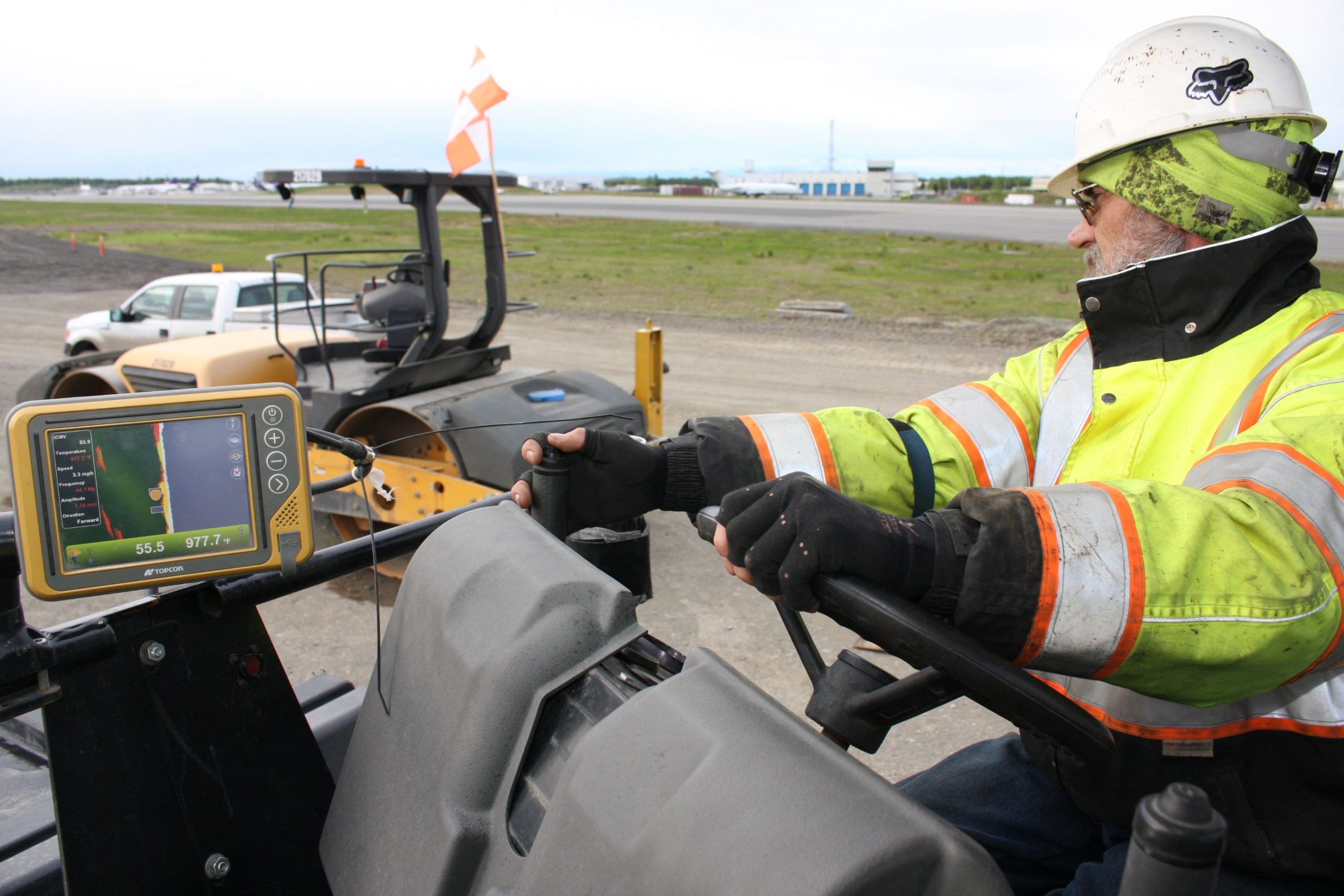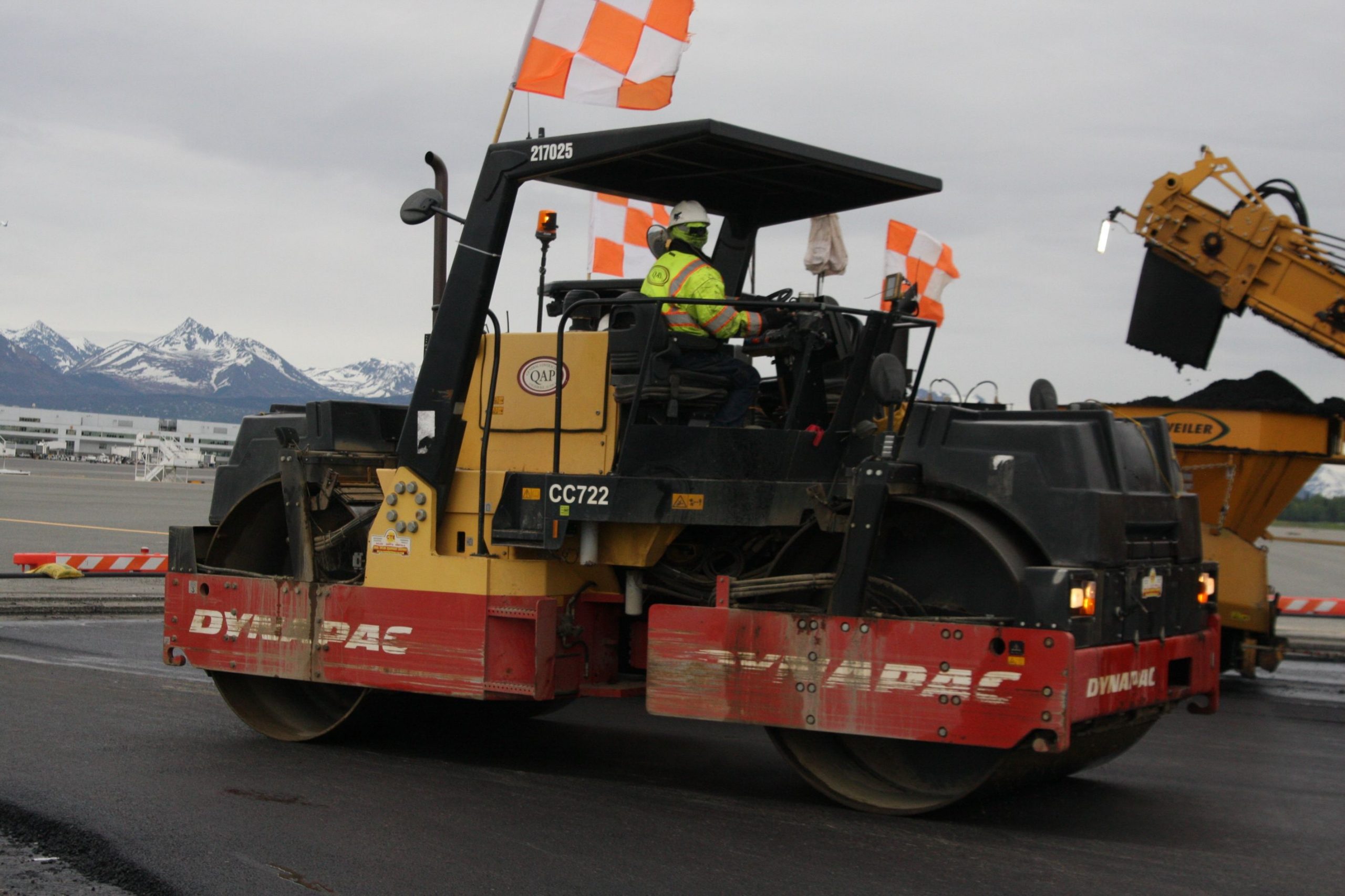AsphaltPro Magazine| AsphaltPro Magazine | Quality Asphalt Paving Upgrades Anchorage Airport
Alaska’s largest city is currently witnessing a case of new technology clearing the way for…new technology. At Ted Stevens Anchorage International Airport (TSAIA), Quality Asphalt Paving (QAP), based in Anchorage and a subsidiary of the Colaska Group, recently performed a major overhaul of the primary north/south runway to accommodate today’s bigger, heavier cargo aircraft.
To help make that happen, the company assembled a fleet of heavy equipment, most of it employing GNSS-based technology. Facing only a six-month window to finish work on the nearly two-mile-long runway, shoulders and adjacent taxiways, QAP achieved outstanding results in earthmoving, milling and paving.
Cargo is Key

While TSAIA handles its share of passenger traffic—more than five million people annually—the airport’s real strength is as a key hub for cargo traffic. Strategically located between the world’s two largest e-commerce markets, China and the United States, TSAIA ranks fifth in the world in air cargo, growing by 2.52 percent to 2.79 million metric tons in 2018 alone. According to Martin Meenaghan, QAP’s project engineer, the stream of cargo-laden jumbo jets into and out of the facility on any given day is virtually non-stop.
“This airport sees some of the largest aircraft flying today, including ‘The Dreamlifter,’ which Boeing uses to transport entire wings of commercial aircraft,” he said. “We were tasked with bringing the runway up to new FAA specs designed to better handle these—and larger—aircraft as the airport moves forward….We were contracted to widen the structural section of the runway. So, while the footprint of the runway will remain essentially the same, the weight-bearing section of it was widened by some 65 feet.”
Upgrade work at TSAIA started with a 1,500-foot section of runway so QAP could gain familiarity with the technique they would use for milling the entire structure: Topcon Millimeter GPS. However, work began later with the shutdown of runway 15/33, and the diversion of all traffic to the east/west runway (07/25) at the southern end of the airport.
Flights to Lights

QAP’s work at TSAIA ran the gamut from preliminary earthmoving to milling to paving to prep for landing light installation. To help them handle each facet in the most efficient way possible, the company called upon Mike Williams, co-owner of GPS Alaska, based in Anchorage, to discuss equipment and control solution options available to them. Doing so was not just the proverbial “shot in the dark.” For several years now, their parent company, Colaska, has been one of Topcon’s strategic partners.
“We enjoy a great relationship with Colaska and worked hard to win them over,” Williams said. “…we knew they could benefit from what Topcon had to offer. We sat down with Joe Webb, Robb Dunn and Mike Fizette and showed them all that was available, finally doing a ‘Fly and Try’ into Topcon’s Livermore, California, test center. There, each potential user got a chance to see and test the technology that could improve their effort….Today, thanks to their commitment, they are one of our best proponents of GNSS solutions, and it showed out at the airport.”
The lineup QAP brought to bear at TSAIA included: a John Deere 850 dozer, a Cat D6N dozer with 3D-MC MAX, and a Cat D6T dozer with 3D-MC2 machine control; a Cat 16M motor grader running twin 3D-MC; a Komatsu 1200 excavator with X-53i indicate-only GPS; a Wirtgen W250i milling machine with dual Millimeter GPS; two CAT F Series pavers; a pair of Cat CB-68B rollers and a Dynapac 700 roller with Topcon C-53 IC Intelligent Compaction; and four Topcon FC-5000 data collectors.
The runway began as 11,470 feet long and 200 feet wide. Excavation work included digging a full-length trench on either side of the runway and filling each trench with gravel to provide the additional structural stability. Work in this area also included new piping systems for drainage. Runway Safety Areas (RSAs), which extend off the pavement, were excavated at 2 feet deep, 110 feet wide the entire length of the runway. According to Meenaghan, having machine control at work made a significant impact.
“With everyone working off the same a model, things are roughed in quickly—it’s all very efficient,” Meenaghan said. “We were out here for seven weeks and had the bulk of the earthwork knocked out. It turned into a paving show much sooner than we ever anticipated. Granted, there are always weather days that we always have to anticipate up here, but it’s nice to get a bit of breathing room so early on.”
Having that level of efficiency in all phases of the project was not just a luxury. While there’s no incentive built into QAP’s contract for finishing the TSAIA project early, there was a penalty of $18,000 per day between two phases for delays beyond the contracted end date.
“For us, the incentive to finish early is this: we’re done, we’re under budget, we did a good job and the customer is satisfied,” Meenaghan said.






